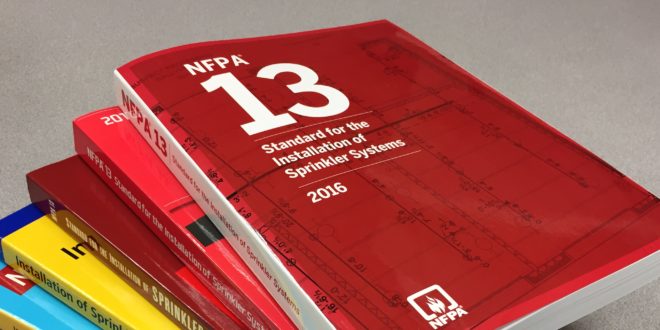
Alternate Protection for Rack Storage
An Answer for Many Problems Including Sloped Ceilings
When a localized portion of the rack has a commodity that requires a design basis greater than what the ceiling system can provide, there is an alternate protection scheme within the rack that requires far less water than a ceiling system (even ceiling systems with in-rack sprinklers). Though it’s stated intent is to address higher hazard commodities, it also provides a design basis for storage with sloped ceilings. Although this article will focus on nuances about the method itself, the main message is that there is now an option other than installing a new horizontal ceiling when the ceiling is sloped.
This option is addressed in the 2016 edition of NFPA 13, Standard for the Installation of Sprinkler Systems, sections 16.1.2.4 and 17.1.2.9 with the latter stating: “The protection of Group A plastic commodities requiring a greater level of protection than is available from the overhead sprinkler system shall be permitted to be protected in accordance with 17.1.2.9.1 through 17.1.2.9.7.” Chapter 16 uses the identical verbiage excepts references Class I through IV and its own section numbers. Let’s start off by discussing what this criterion applies to. It’s an interesting choice of words to say when one requires more protection than is available from the overhead sprinkler system. If one interprets the use of “available” to mean as is currently installed, that would mean it applies only when performing an evaluation of an existing system. This is not the intent (although it obviously can be applied to it). To get a better understanding of intent, let’s start with the fact that a single system can have more than one design basis. As stated in section 11.1.1: “A building or portion thereof shall be permitted to be protected in accordance with any applicable design approach at the discretion of the designer.” The phrase “portion thereof” confirms we can have more than one design basis. So, when looking at a new design where the majority of the space contains a Class I commodity, the entire ceiling could be based on Class I and this criterion could be applied just within the rack in the portion of the building that contains Class IV commodity. Naturally, the owner has to understand that all future similar products must be located only in the segregated portion of the rack (or that rack modifications be expanded) but that’s a different story. The main question that comes to my mind is whether it applies to exposed, expanded Group A plastics. To provide as brief an answer as possible, when it says applies to Group A plastics, it indeed means any Group A plastic commodity. If it didn’t, it would state the limitations as done in the other sections.
This criterion can be applied when there is no other guidance (within NFPA 13) such as exposed expanded Group A plastic when using spray sprinklers. It’s also of great value when the water supply is marginal and a localized higher ceiling demand would drive you to a water pump. For example, for exposed expanded Group A plastics in racks, the only identified option is ESFR sprinklers with a K-Factor of 25.2 flowing at 60 psi. This would require around 2,900-plus gpm (with overage) at 120-plus psi. It’s also limited to storage no greater than 35 ft and buildings no higher 40 ft (as well as the obstruction headaches). Amazingly, for the above example, this alternative approach for the more demanding double or multiple row racks would have a system demand of only around 570 gpm at 45 psi. Considering all these factors, plus the fact that this approach includes no ceiling sprinklers, a better way of phrasing it would have been “than available from an overhead sprinkler system.” Also, allow me to emphasize that it is only in chapters 16 and 17 so it applies to standard commodities and does not apply to rolled paper, rubber tires, etc.
So, what tells us that we can use this approach for sloped ceilings? Let’s first start with a reminder about sloped ceilings in storage (since this question still comes up with some regularity). Section 12.1.2 states: “Ceiling Slope. The sprinkler system criteria specified in Chapter 12 and Chapters 14 through 20 are intended to apply to buildings with ceiling slopes not exceeding 2 in 12 (16.7 percent) unless modified by a specific section in Chapter 12 and Chapters 14 through 20.” Although the use of the word “intended” is rather soft, it’s telling us there is no criteria when the ceiling slope exceeds 12 in 12. Many assume that simply applying a 30 percent increase to the size of the remote area accounts for the slope. That allowance is discussed in section 11.2.3.2.4 and it explicitly states “ … in nonstorage applications.” That is until now, but unfortunately it is not yet stated as an allowance in NFPA 13. So why do I make this claim? In order to get to the answer, it’s easiest if we start with discussing how we apply this option when there is a second design basis within the storage family (and a horizontal ceiling). There are two sections that specifically address the design basis outside the boundary of this option. These are:
- “17.1.2.9.2 Commodities that can be protected by the ceiling level sprinkler system shall be permitted to be stored vertically above and horizontally adjacent to the portions of the storage rack equipped as prescribed by 17.1.2.9.”
- “17.1.2.9.7 Ceiling Sprinkler System. The ceiling-level sprinkler system shall be designed based on the highest commodity hazard not protected by the criteria prescribed by 17.1.2.9.”
These tell us that product can be stored above and beside the potion of the rack using the alternative approach. It also tells us that the ceiling density is based only on the product outside the boundary of the option. So, if there was a single tier above the option, then the ceiling would be based upon a storage height of 5 ft (using the standard dimension of 4 to 5 ft per load). In other words, the top boundary of the alternative approach is considered the floor for the contents above it. Now combine the above with section 17.1.2.9.6 that states: “The in-rack sprinkler demand shall not be required to be hydraulically balanced with the ceiling-level sprinkler system. There is no interaction between the ceiling sprinklers and the in-rack sprinklers.” For all intents and purposes, this portion of the rack is treated as a different compartment.
So, the next question is: if the boundary of this option (that being the required horizontal barrier) is over the top tier of the rack so there is nothing above it, what is the required design basis at the ceiling? This is no different than the area above the drop ceiling for an office located within a warehouse. Other than the 15-ft extension of the adjacent higher hazard (for which there is none if the entire warehouse is using the alternative approach), the design basis would be a light hazard occupancy. This would not be a recommended ceiling density for a facility that could change storage arrangements in the future, but for this scenario it’s adequate protection for an area that contains no fuel load. The debate as to what design basis should be applied is also a different story, but that portion is not being used for storage. We are quite comfortable assigning different uses of floor space when separated horizontally and granted we aren’t used to treating the vertical spaces differently but that is the case. A last point is in order to ignore a ceiling slope greater than 2 in 12, the entire warehouse would have to be rack storage using this approach (aka no solid pile storage) or have areas used for other uses that are protected using the occupancy hazard approach. Additionally, putting a barrier above the top tier can be a pain unless you are lucky enough to be able to request the rack uprights be extended (without a horizontal member so as to avoid any attempts to push the storage higher). Until the conclusion of this line of logic is added to NFPA 13, it’s to be treated as an alternate approach under section 1.5 that requires approval of the Authority Having Jurisdiction (AHJ).
Regardless of the sloped ceiling application, this option has many potential uses, so it’s worth spending a little time discussing some of the details about it. This option is effectively blocking off a portion of the rack and putting in a bunch of in-rack sprinklers that are flowing a bunch of water. The boundary always consists of a horizontal barrier at the top but not always the sides. In horizontally separating this portion of the rack from adjacent commodities, there’s a choice of either a vertical barrier or extending the in-rack sprinklers one pallet load in all directions. I think that’s an easy choice. It’s interesting that other alternate schemes like the ESFR for exposed expanded Group A plastics requires a vertical barrier but that’s a ceiling-only approach. Another way of looking at this difference is that it’s a testament to the effectiveness of in-rack sprinklers.
The portion of the rack is also divided with horizontal barriers typically located at every other tier. It’s not by the number of tiers but a maximum vertical spacing of 12 ft. The barriers can be sheet metal (minimum 22 gauge) or plywood (minimum 3/8 in.). On a related note, this sheds some light on the ambiguous guidance for horizontal barriers in sections 16.1.9 and 17.1.8. These sections accompany the options that require barriers with ceiling spray sprinkler and simply identify the allowed types of materials. The annex then says it shall be of sufficient strength to avoid sagging. The barriers are also required to cover the entire area including the longitudinal and transverse flue (with one exception). As similarly identified elsewhere for in-rack barriers, it must be fitted around vertical rack members (and pipe which isn’t mentioned elsewhere). This also has a related note on the gaps which contributes confusion instead of clarity. The definition of “horizontal barriers” (section 3.9.5) states all flues shall be covered. The new option also states all flues shall be covered. Now, to the allowed gap around the uprights. The barrier criteria in sections 16.1.9 and 17.1.8 says within 2 inches around the uprights whereas 16.1.2.4.3.4(3) says within 3 inches of vertical rack members. This is a minor difference in allowed dimensions that we’ll hopefully correlate later but most would interpret both to mean the gap is immediately adjacent to the upright. That is not the case. All of the figures for the alternative approach say at the rack upright but they show the gap running the entire transverse flue between the uprights (aisle to aisle). This obviously has to be resolved next cycle. It is noteworthy that every gap has an in-rack sprinkler at every longitudinal flue and for double- and multiple-row racks, face sprinklers. Allowing gaps between the uprights for all barriers is appropriate if there are similar in-rack sprinklers at the gaps (another discussion to be had with your AHJ).
There is one last nuance I wanted to discuss is on the in-rack sprinklers. There are several interesting aspects to them. One is that either ceiling-only or in-rack sprinklers can be used. Considering that there is a really large shield (aka the barrier) above them, why only require a sprinkler with a really small shield? Another aspect is that the design basis for Class I to IV is the same as that for Group A plastics. The required discharge is 60 gpm (with six sprinklers calculated for single-row rack and eight sprinklers for double- and multiple-row racks). It’s also interesting that a minimum K-factor of 8.0 is identified. Considering that will require a starting pressure of 56.3 psi. are they going to be used very often?
Obviously, this article did not attempt to cover all the installation details associated with this alternate approach because they are pretty straightforward. The main point is that despite the pain associated with installing horizontal barriers, this alternate approach can solve a lot of problems.

ABOUT THE AUTHOR: Roland Huggins, PE is the senior vice president of Engineering and Technical Services for the American Fire Sprinkler Association. He is a graduate of the University of Maryland and registered in Fire Protection Engineering. He is a member of the National Fire Protection Association (NFPA). Huggins has served on the NFPA Standards Council and is a member of multiple NFPA technical committees, including NFPA 13 Correlating Committee, NFPA 13 Discharge Criteria, and NFPA 5000 (Building Code) Correlating Committee. NFPA activities have included participating on the editing of the Sprinkler Handbook and the Fire Protection Handbook. Other national activities involve the NFPA Research Foundation, UL Standard Technical Panels, and NICET. He has conducted many seminars and presentations as well as written numerous sprinkler-related articles. Huggins is a veteran.
EDITOR’S NOTE: Text from NFPA standards reproduced with permission from NFPA 13-2016, Standard for the Installation of Sprinkler Systems, Copyright © 2015, National Fire Protection Association, Quincy, MA. This reprinted material is not the complete and official position of the NFPA on the referenced subject, which is represented only by the standard in its entirety which may be obtained through the NFPA website at www.nfpa.org.
IMPORTANT NOTICE: The article and its content is not a Formal Interpretation issued pursuant to NFPA Regulations. Any opinion expressed is the personal opinion of the author and presenter and does not necessarily present the official position of the NFPA and its Technical Committee.

 Sprinkler Age A Publication of the American Fire Sprinkler Association
Sprinkler Age A Publication of the American Fire Sprinkler Association
